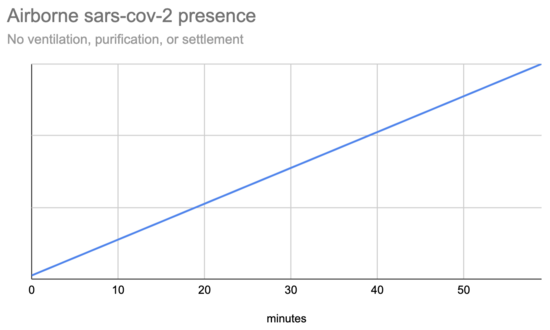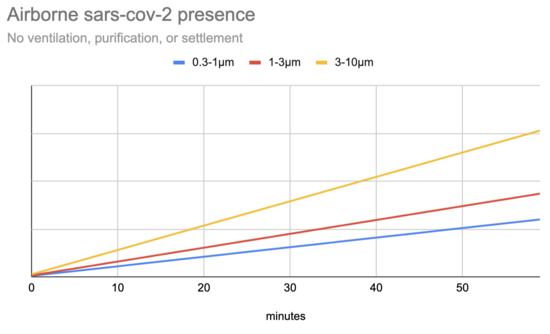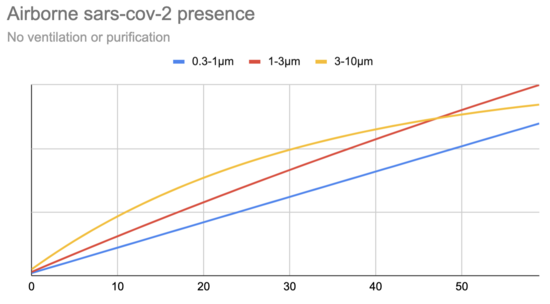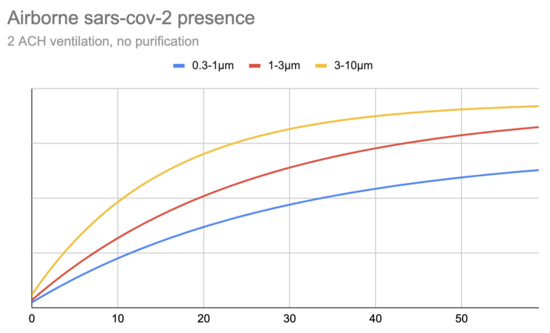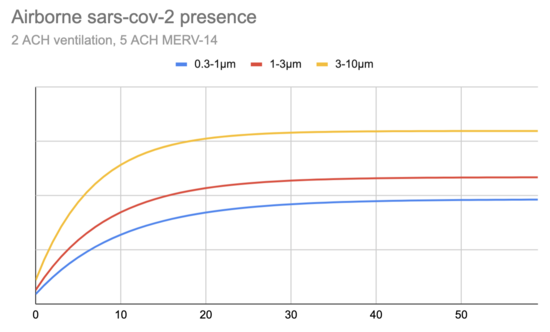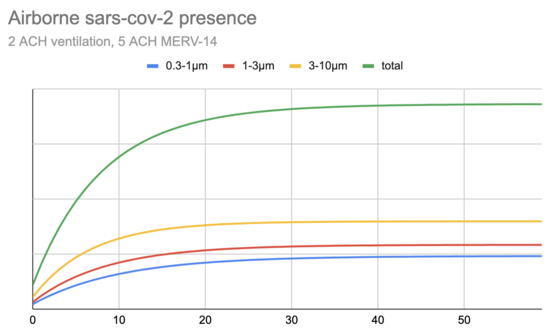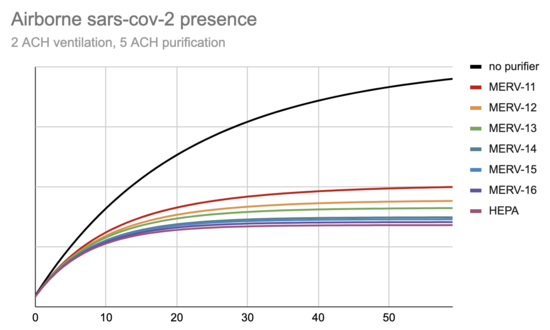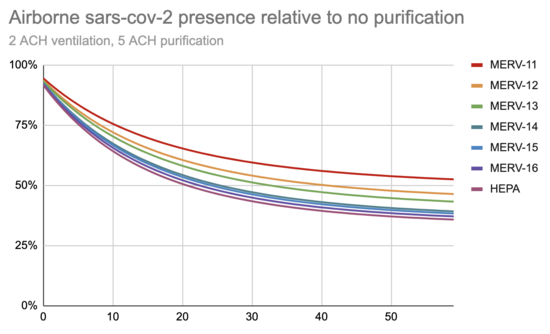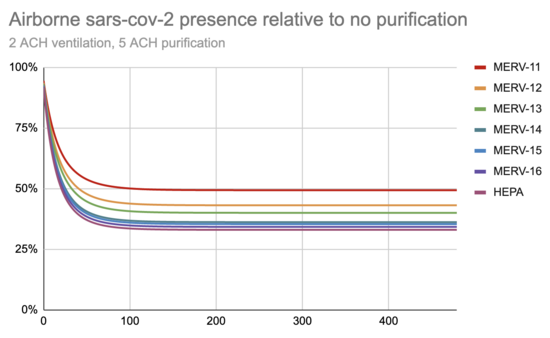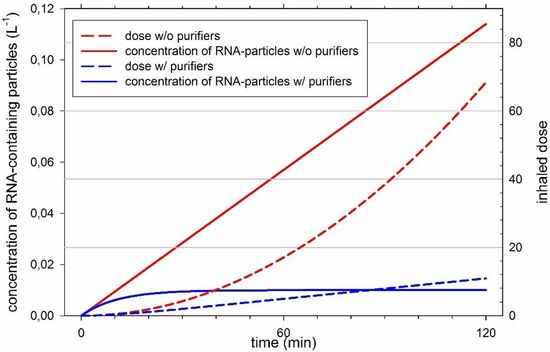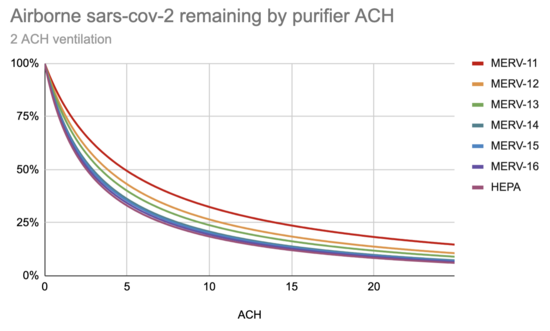If you look around for advice on what kind of air purifier to use to reduce covid risk, you'll see some people saying you need HEPA filters:
If you decide to buy an air purifier for COVID purposes, here's some things to keep in mind:
- Make sure the purifier has a HEPA filter - these are rated to remove 99.97% of airborne particles.
- Central heat / AC systems don't work for this. These typically use MERV-rated filters. These are significantly less effective at removing small particles than HEPA-rated filters (the best MERV rating, MERV-16, merely removes 75% of particles. [JK: this should be 95%—filed #1451]
The EPA, however, advocates anything that removes 0.1-1 µm particles well, and recommends MERV-13 or better if you're building something:
In order to select an air cleaner that effectively filters viruses from the air, choose: 1) a unit that is the right size for the space you will be using it in (this is typically indicated by the manufacturer in square feet), 2) a unit that has a high CADR for smoke (vs. pollen or dust), is designated a HEPA unit, or specifically indicates that it filters particles in the 0.1-1 µm size range.
...
When assembling a DIY air cleaner, choose a high-efficiency filter, rated MERV 13 or higher, for better filtration.
Where does the recommendation to use MERV-13 come from? Can I use MERV-12? If I use MERV-14 instead how much better will it be? Let's model it.
Imagine you have an infected person who enters a room. They exhale sars-cov-2 particles, which slowly accumulate:
These particles are a range of sizes, but let's approximate that 20% of the airborne sars-cov-2 is in particles of size 0.3-1µm, 29% in 1-3µm, and 51% in 3-10µm (see How Big Are Covid Particles?):
The particles don't actually accumulate forever, for several reasons, one of which is that they typically slowly settle out of the air. This depends on size, with half lives of ~4d for 0.3µm, ~2hr for 2µm, and ~20min for 5µm:
Another reason particles don't accumulate forever is the same reason that even with the windows closed we don't suffocate: buildings aren't airtight. You describe how much ventilation a building has in "air changes per hour" (ACH), and a typical value for residential construction is 2 ACH. For example, if your room is 1,000 cubic feet (CF) then you might have 2,000 cubic feet of air exchanged with the outside per hour, or 33 cubic feet per minute (CFM):
Now let's imagine we turn on a purifier that runs 5 ACH (83 CFM in a 1,000 CF room) through a MERV-14 filter. This is rated to remove at least 75% of 0.3-1µm particles, 90% of 1-3µm, and 95% of 3-10µm:
The total amount of sars-cov-2 in the air is the sum of these three curves:
What happens when we run different filters with different efficacies?
We can also look at each of these filters relative to a situation with no filtration:
Let's extend the scale a little so we can see how long it takes to stabilize:
In equilibrium, we see the following amounts of sars-cov-2 relative to no filtration:
| Filter | Presence |
|---|---|
| MERV-11 | 49% |
| MERV-12 | 43% |
| MERV-13 | 40% |
| MERV-14 | 36% |
| MERV-15 | 35% |
| MERV-16 | 34% |
| HEPA | 33% |
This is a little surprising: Microcovid estimates that in this situation ("Indoors with a HEPA filter (flow rate 5x room size per hour)") risk is reduced to 25%. They cite Curtius et al. 2020 and summarize as:
Researchers found that running air purifiers in a classroom decreased the aerosol density in the room by 90%.This is not a great summary of the paper. The researchers did two different things:
- Measured the effect of air purifiers on particle concentration.
- Made a simple model of the effect of purifiers to estimate the decrease in risk.
Their model does not include any natural ventilation or decay, which means that their modeled "concentration of RNA particles without purifiers" will increase linearly forever. It's 10x higher than with purifiers after 2hr, but after 4hr they would say it was 20x higher.
A HEPA filter at 5 ACH reducing airborne sars-cov-2 to 33% in equilibrium is still pretty good, but how much airflow do we need to get levels down to the 25% of what they would be without a purifier?
We can get this from looking at how much reduction we have in equilibrium by ACH:
This shows we would need 7 ACH from a HEPA filter to get levels down to 25%, but it also shows that the effect of higher airflow can be larger than higher filtration. If we have a target of reducing equilibrium levels to 25% of what they would have been, how many ACH would we need with each filter type?
| Filter | ACH to match HEPA |
|---|---|
| MERV-11 | 13.8 |
| MERV-12 | 10.6 |
| MERV-13 | 9.3 |
| MERV-14 | 8.0 |
| MERV-15 | 7.7 |
| MERV-16 | 7.4 |
| HEPA | 7.0 |
This lets us answer the question of when it's worth it to use a higher-quality filter when building a purifier. Let's say I'm building several filter cubes to purify the air in a large room, perhaps 9,000 CF and I want to reduce levels to 25%. I'll need 1,000 CFM of 100% filtered air, or more of less thoroughly filtered air. Each cube can move about 500 CFM through its filters, so I would need:
| Filter | Required Cubes |
|---|---|
| MERV-11 | 3.9 |
| MERV-12 | 3.0 |
| MERV-13 | 2.7 |
| MERV-14 | 2.3 |
| MERV-15 | 2.2 |
| MERV-16 | 2.1 |
| HEPA | 2.0 |
At today's prices (per 20x20x1 filter, shipped in a pack of 12) I see:
| Filter | Required Cubes |
|---|---|
| MERV-12 | $6.24 |
| MERV-13 | $7.24 |
| MERV-14 | $11.58 |
I don't see reasonable prices on MERV-11 (more expensive than the cheapest MERV-12) or MERV-15+ (far more expensive than MERV-14).
How do the costs compare if we hold filtration constant and assume we can use fractional cubes? Lets say a cube is a $25 box fan, $1 of tape, and four filters:
| Filter | Required Cubes | Total Cost |
|---|---|---|
| MERV-12 | 3.0 | $153 |
| MERV-13 | 2.7 | $148 |
| MERV-14 | 2.3 | $166 |
It looks like the standard advice to use MERV-13 is pretty good! On the other hand, using MERV-14 lets you get almost as much filtration for your dollar using fewer cubes, which means less space and noise. And, of course, you can't really have fractional cubes, so it may make sense to round up or down based on the size of the particular room you're purifying.
(Code is on
github and charts are in this sheet.)
Comment via: facebook
